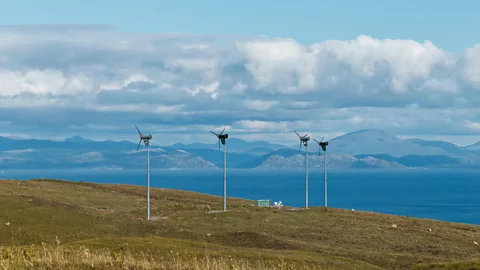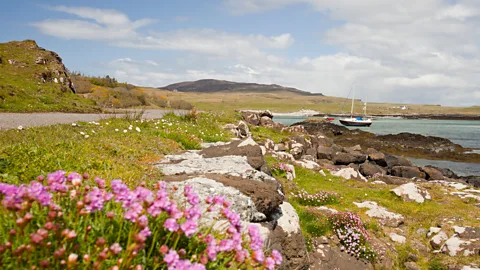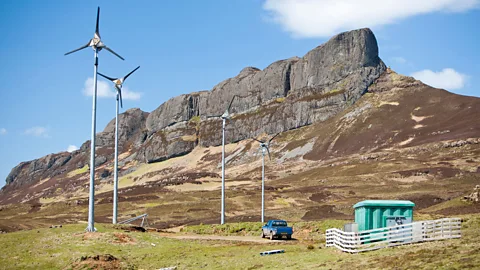The Isle of Eigg: The community-owned island that powers itself
 markferguson2/Alamy
markferguson2/AlamyDespite being one of the smallest Scottish islands with just 110 residents, the Isle of Eigg is a model of forward-thinking, sustainable, eco-conscious living.
As the ferry bobbed with the ebb and flow of the tide against the concrete pier at the Isle of Eigg, there was a delay before the passengers could disembark. Boxes and parcels were heaved up from the boat to the waiting hands above, and the bow was double-checked to ensure nothing had been forgotten. Last to be unloaded was a bundle of newspapers, tightly rolled and individually labelled. As they were lifted, one slipped and rolled back towards the steps leading down to the water. It was stopped by the boot of one of the ferry crew just before it reached the edge. Although it was only a paper, even those just arriving seemed to sense the stakes were higher here and shared the relief of the islanders waiting on the pier.
Eigg is one of a collection of islands in the Scottish Inner Hebrides called the Small Isles. It lies 15 miles from the mainland and is reliant on a ferry that runs a few times a week, weather dependent, for supplies and transport. As such, waste isn't an option here and sustainability is a necessity.
"Sustainability has always been a part of island and crofting life here," explained Norah Barnes, Scottish Wildlife Trust ranger on Eigg. "You're a bit more aware of what you're using. You can't just go to a shop down the road to get something. Everything that we want, we literally have to lift off the boat."
Combined, the Small Isles of Eigg, Canna, Sanday, Rùm and Muck have a population of just 150-200 people. Measuring five miles by three, Eigg is the second largest in size but by far the most populous with around 110 residents, and this has helped to foster a community that has collectively been able to take charge of the future of the island.
 Ashley Cooper pics/Alamy
Ashley Cooper pics/AlamyHow to visit
Get there:
There are ferries between Mallaig and Eigg, or between Arisaig and Eigg in summer. You can walk between most places on the island.
Where to stay:
Community owned business Eigg Camping Pods have wooden cabins by the pier; all profits are reinvested in the island. Lageorna for bed & breakfast and self-catering accommodation close to the northern beaches.
Where to eat:
Galmisdale Bay Cafe & Bar for hearty food made with locally sourced ingredients. Lageorna has a 4-star restaurant serving three-course meals (booking is essential)
What to do:
Visit the quartz Singing Sands that squeak and groan underfoot; climb An Sgurr, Britain’s largest pitchstone ridge; hire a bike or kayak and explore the island. Join a guided wildlife walk (May to August – find details in the visitor centre). Learn more about Eigg’s history at the museum in The Old Shop and the Cleadale Crofting Museum.
When to go:
Between May and September for the best weather.
Stepping off the ferry, I walked the short distance to An Laimhrig, the pier centre. Recently expanded and redeveloped to better serve the increasing number of islanders and visitors, the complex is at the heart of community life. As I oriented myself with a map, islanders came and went, collecting deliveries, dropping off letters and buying supplies in the island's sole grocery shop that doubles as the post office, and sharing news in the cafe. As well as the cafe and grocery shop, the complex houses a craft shop, bike hire and a wash house that provides toilets and showers for those wild camping or staying in community-owned camping pods. It's also where the stone monument commemorating the 1997 community buyout of the island stands.
After a run of landlords who were either absent from the island or uninterested in its development, the residents of Eigg were convinced community ownership was the only way to guarantee the island's future. As Maggie Fyffe, secretary of the Isle of Eigg Heritage Trust (the organisation that owns the Isle of Eigg), told me, "The island realised that we weren't going to have much of a community unless we did it ourselves."
When the island came up for sale in 1996, locals began raising money. "The residents contributed, and we had a big fundraising campaign. But we had the famous mystery donor who gave us a million quid in the end, and that's what clinched it."
Although visitors come for many reasons, Eigg is best suited to those with an interest in the outdoors. Its most famous sights are the Singing Sands beach at the north of the island that squeaks and squeals as the quartz sand is disturbed, and the towering pitchstones ridge of An Sgurr, formed some 58 million years ago from a volcanic eruption that looms over the east of the island.
In between are rugged plains, moorland, woodland, miles of coastline and white-sand beaches that could have been lifted from the Caribbean, and even a small section of temperate rainforest. The island is largely untouched by the industries that have altered the countryside across much of Britain. "We don't have very intense farming or agriculture here," said Barnes. "The landscape is conducive to wildlife. There's no commercial fishing or large-scale farming and the coastal line, shore and beaches and sea are clean, clear waters."
To make the most of the clear sky and the view from its summit, I set out to climb An Sgurr. Looking at its face, it appeared unconquerable with towering walls of sheer black stone, but a path that curves around its back offered a relatively easy climb to the top. At nearly 400m, the views from the summit were incredible, extending out towards Rùm, Skye and the mainland. But nowhere offers a better panorama of Eigg itself, and as the wind picked up, my eyes were drawn down to where the island's wind turbines were churning the air.
 Vincent Lowe/Alamy
Vincent Lowe/AlamyLaunched in 2008, Eigg was the world's first community to launch an off-grid electric system powered by wind, water and solar. The three systems complement each other so that almost any weather condition is conducive to producing electricity. To ensure supply, there are still backup generators, but the overwhelming majority comes from renewable sources. "How much renewables we use varies depending on the weather, but we've done as much as 90%," Fyffe explained.
The benefits of the new renewable system have been numerous. Before, the island was reliant on diesel generators, which Barnes explained was a logistical headache. "You had to get the diesel shipped over, decant it into barrels, get the barrels to your house and fill up your generator. It was a massive job. Using renewable energy has improved things a lot for people's daily lives as well as the environment."
It's also a step towards self-sufficiency, and, with the global energy crisis pushing prices up around the world, Fyffe described how it's helped protect the island from the increased cost of living. "To begin with, our unit charge was higher than the mainland, but we're probably cheaper now. We put it up slightly from time to time, but we haven't done this the last couple of years as it's been so tough for everyone."
The island isn't resting on its laurels. Eigg is continuing to work towards becoming more sustainable. "We're involved with another feasibility study looking at how we could become carbon neutral," Fyffe said. "We're hoping to build a house and renovate the old doctor's surgery for rent, and we're going to trial air source heat pumps [running off the electricity grid] to see how efficient they are. Then, people can move in that direction. We'd need more supply for this, probably three big turbines, although this is early days."
 Ashley Cooper pics/Alamy
Ashley Cooper pics/AlamyFor heating, most of the island currently uses wood-fuel stoves. Eigg is running a sustainable forestry project to ensure supply, felling trees to provide firewood for the islanders and timber for export while simultaneously replanting and expanding woodland. To aid the reforestation, Barnes explained, "A tree nursery has been set up for new trees to replant where the old trees were cut down. Some will be [used for] wood fuel, and some will be retained for wildlife. These are native trees they're growing. Hardy stock.
Carbon Count
The travel emissions it took to report this story were 0.39 metric tons of CO2e. Find out more about how we calculated this figure here.
The population on the island is currently the highest it's been for at least half a century. Eigg also seems to have avoided the issue of second homes that affects some Scottish islands and leave communities hollow in the winter. In fact, walking across the island, the main challenge seemed to be providing a permanent home for residents living in caravans or temporary accommodation.
"We're trying to provide houses for the people that live here. We have quite a few people on temporary accommodation so [the Trust is] trying to increase the properties available for rent," Fyffe said. "There are quite a lot of people waiting for a rental property to come up."
But, while infrastructure catches up, this growth and demand for housing is a positive sign that counters the threat of depopulation faced by many islands. And this optimism seems to be shared by the wildlife. "We had a pair of sea eagles come back to the island four years ago after being extinct on Eigg," Barnes told me. "They were reintroduced to Rhum but came back to Eigg [themselves] and have produced young for the last three years."
---
Join more than three million BBC Travel fans by liking us on Facebook, or follow us on Twitter and Instagram.
If you liked this story, sign up for The Essential List newsletter – a handpicked selection of features, videos and can't-miss news delivered to your inbox every Friday.
